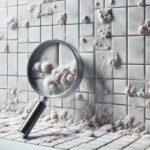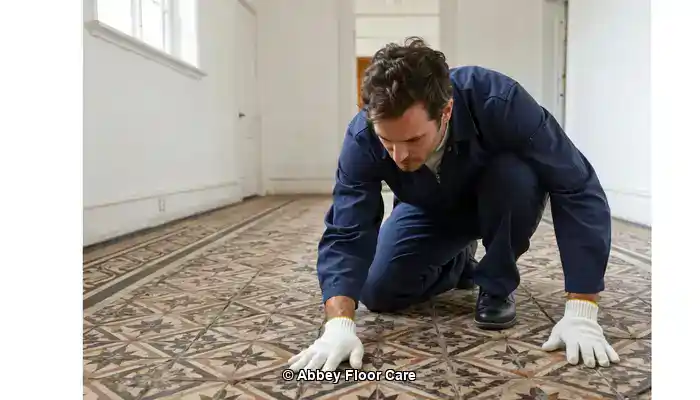
Last Updated on October 30, 2025 by David
Essential Insights for Successfully Restoring the Colour and Pigment of Faded Victorian Mosaic Tiles
- Victorian mosaic tiles frequently experience colour loss due to the accumulation of dirt, age-related coatings, and surface wear, which are not solely attributable to their age.
- Avoid harsh chemicals and vigorous scrubbing as these methods can irreversibly damage original pigments, particularly on encaustic and geometric tiles.
- Effective restoration initiatives commence with a thorough deep cleaning using pH-neutral solutions paired with low-speed rotary equipment and soft brushes to protect tile surfaces.
- Removing old sealers and waxes is vital to reveal the true condition of the tile surface, setting the stage for successful restoration.
- Enhancing colour can be accomplished through breathable, stone-safe sealers that enrich the hues without imparting a glossy finish on the tiles.
- Professional restoration techniques can rejuvenate original pigments without resorting to repainting or artificial colours, thereby preserving the tiles' authenticity and historical value.
- Maintaining restored tiles necessitates gentle cleaning practices and steering clear of acidic or bleach-based products that could jeopardize the surface integrity.
- Heritage-sensitive restoration techniques are critical for safeguarding the aesthetic and historical significance of the tiles, ensuring that the restoration respects their original character.
Exploring the Importance of Restoring Victorian Tiles to Their Original Glory
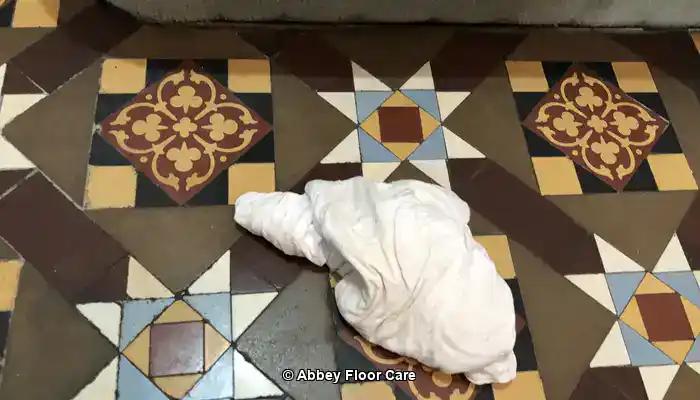
Abbey Floor Care restoring the colour to a Victorian clay tile floor using a colour-enhancing impregnating sealer.
Victorian encaustic and mosaic tiles are a vital component of British architectural heritage, celebrated for their intricate craftsmanship and unique colour palettes that are derived from mineral pigments embedded within the clay tile bodies. Over time, these stunning tiles may lose their vibrant appearance due to various factors, including environmental conditions and surface wear. A thorough understanding of the restoration process is key to successfully reviving their original beauty and ensuring their longevity for future appreciation.
Expert Recommendations: Optimal Products for Daily Care of Victorian Tiles
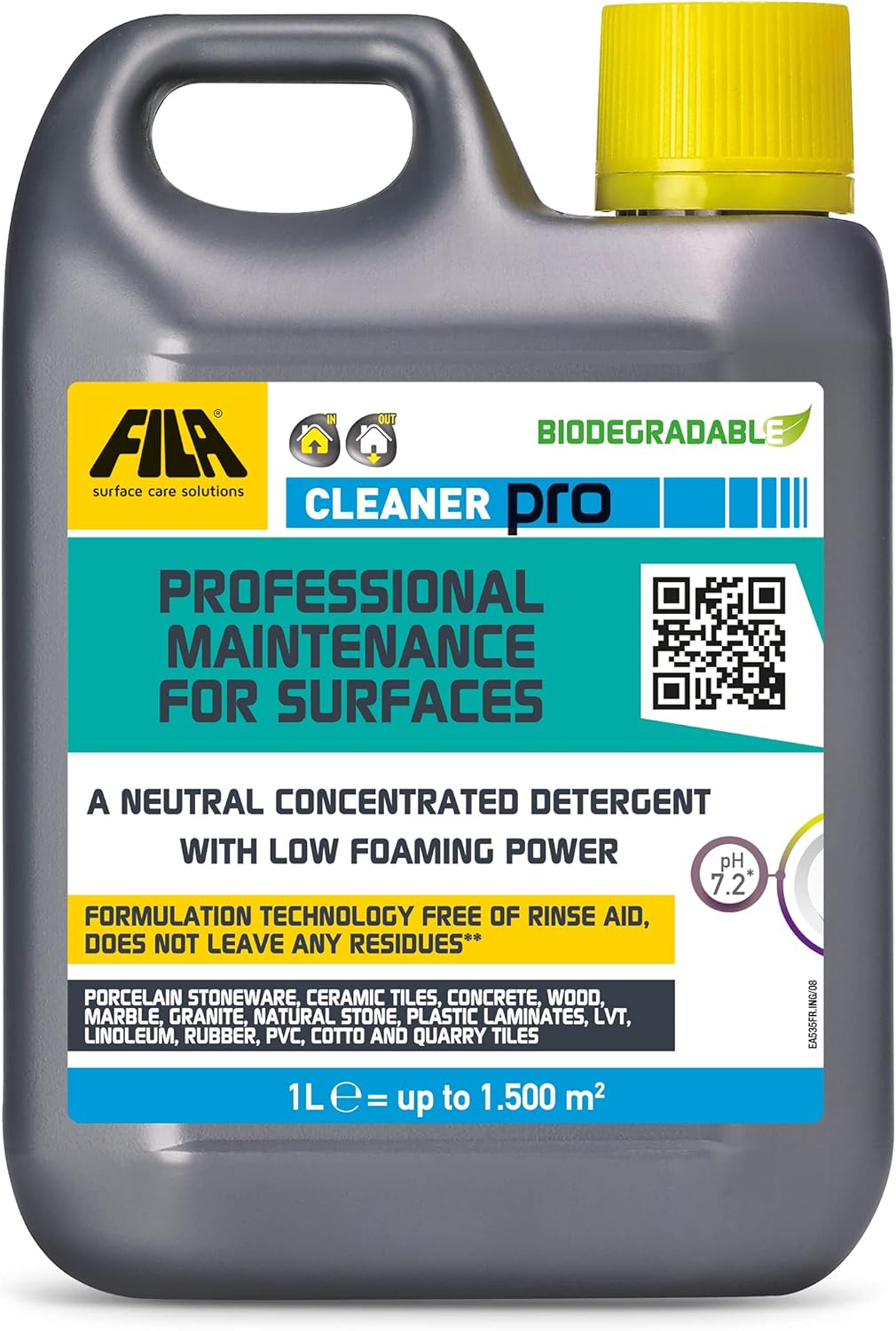
Fila Pro Floor Cleaner
|
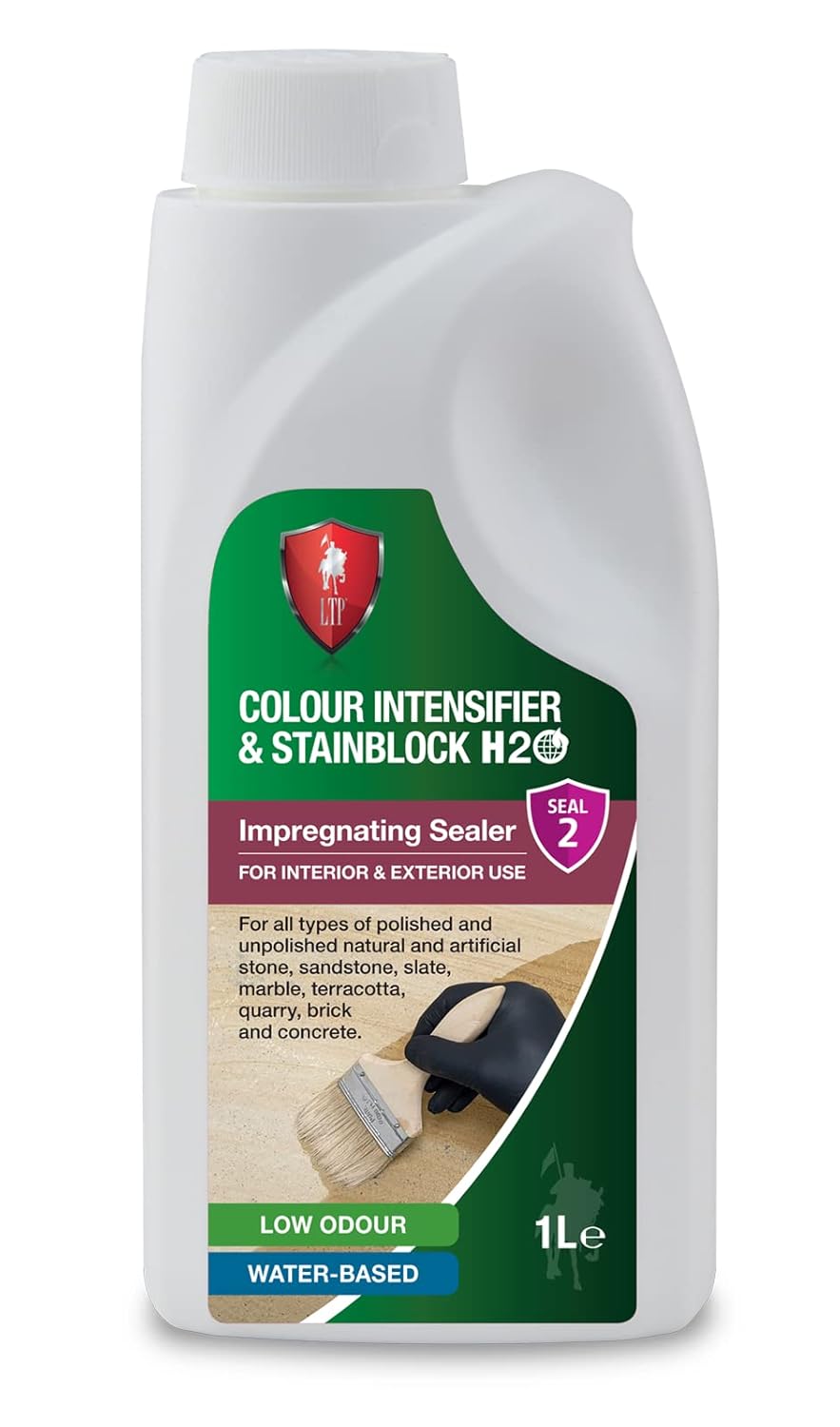
LTP Colour Intensifier & Stainblock H20
|
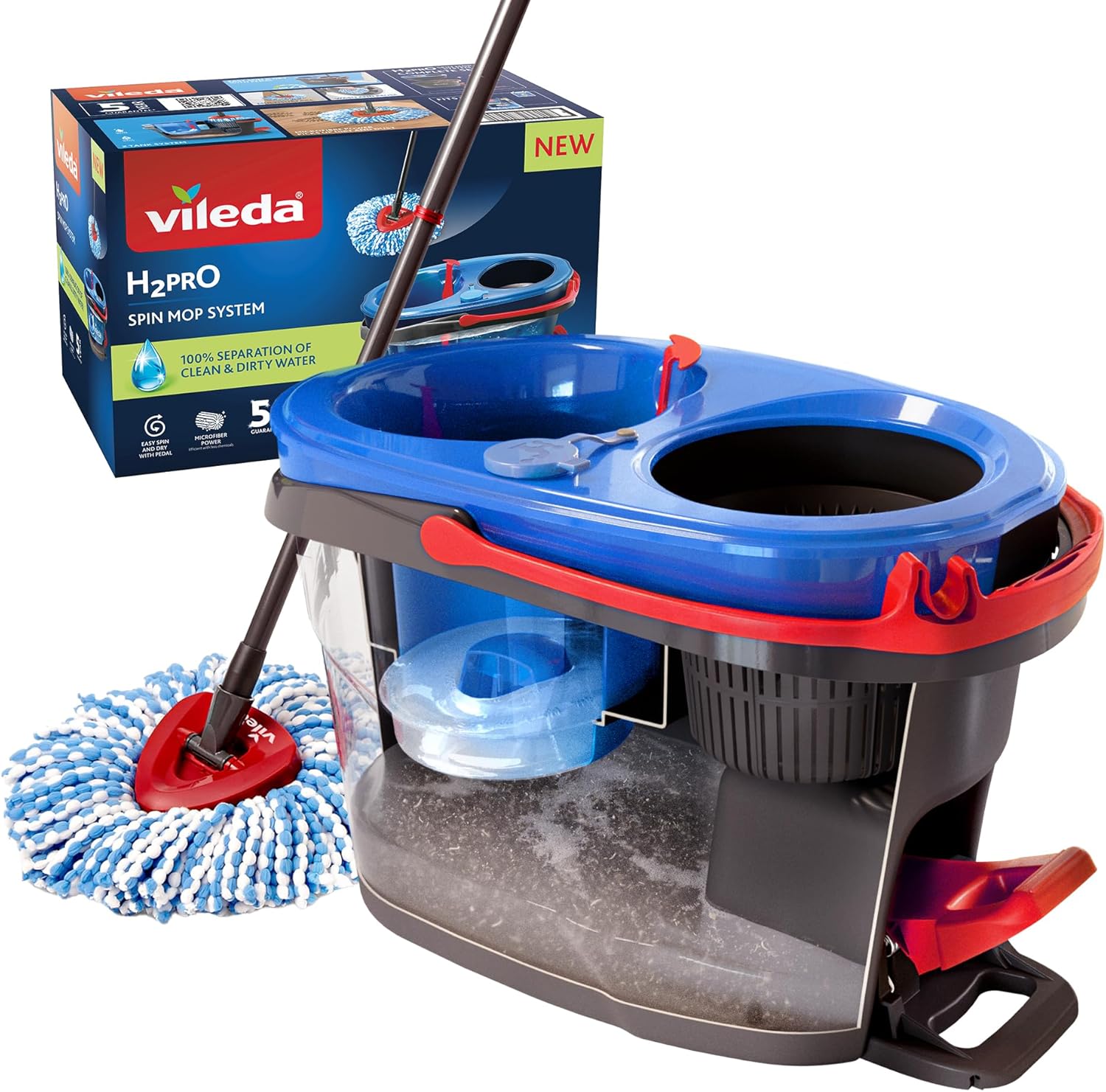
Vileda H2PrO Spin Mop System
|
Nevertheless, these exquisite tiles can gradually lose their visual charm due to a variety of factors, including wear from foot traffic, chemical interactions, and environmental influences. The restoration process necessitates specialized knowledge of the materials involved, historically informed techniques, and the use of high-quality products specifically designed for enhancing and preserving these beautiful surfaces, ensuring they remain a stunning feature in any setting.
Identifying the Factors That Contribute to the Fading and Dulling of Victorian Mosaic Tiles Over Time
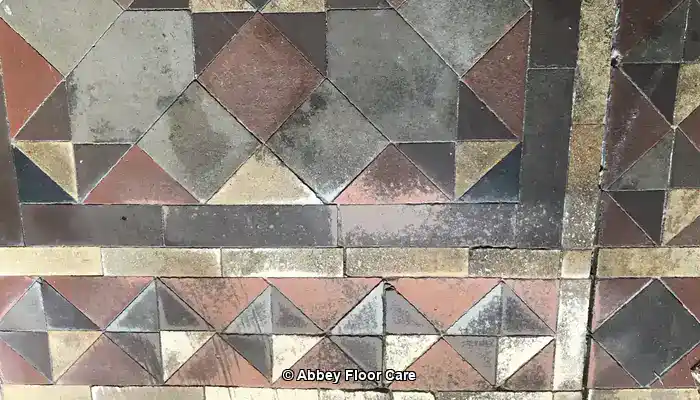
Example of Victorian Clay Tile Floor dulled through surface wear and damage.
The pigments that are integral to the tile's structure can fade and dull due to several contributing factors:
- Accumulated dirt and grime: Continuous foot traffic results in the deposition of fine particles and oils that permeate porous surfaces, scattering light and diminishing the vibrant colours that originally characterized the tiles.
- Wax and polish build-up: Layers of non-breathable wax or sealants can trap moisture, leading to a cloudy or yellowed appearance that obscures the tile's original charm and beauty.
- Moisture-related issues: Many Victorian tiles were installed over subfloors lacking damp-proof membranes, leading to rising damp and soluble salts. These salts can crystallize on the tile surface as efflorescence, which further masks the original hues and diminishes their visual appeal.
- Physical abrasion: Small scratches accumulate over years of use, disrupting the smooth light reflection and reducing the visual richness of the tiles, ultimately affecting their overall appearance.
Effective restoration techniques concentrate on addressing each of these contributing factors while simultaneously preserving the historic integrity of the tiles, ensuring they are restored to their former glory.
The Essential Role of Breathability for Victorian Tiles Lacking Damp-Proof Membranes
Many Victorian tiled floors are situated on older subfloors that do not have a damp-proof membrane (DPM), necessitating that their natural clay structure remains permeable. This permeability allows moisture from the subfloor to evaporate naturally. Non-breathable wax coatings or film-forming sealers obstruct this essential evaporation, leading to moisture accumulation beneath the surface. As a result, trapped salts and humidity can cause efflorescence and mineral degradation, as well as the undesirable phenomenon known as wax blooming—a whitish haze that detracts from the tile's visual appeal. Restoration strategies must prioritize breathable impregnating sealers that protect the tiles while allowing moisture vapor to escape freely, thereby preventing long-term damage and preserving their beauty.
Diving Deep into the Pigments and Composition of Victorian Tiles
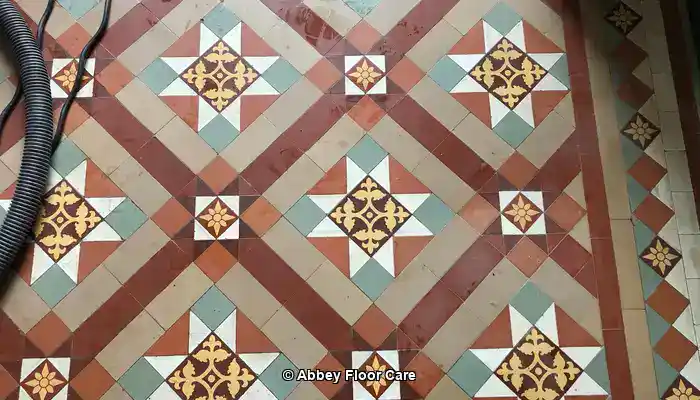
An example of different pigments in a Victorian Clay tile floor during restoration by Abbey Floor Care
Unpacking the Mineral Oxide Pigments Found in Victorian Tiles
Victorian mosaic and encaustic tiles derive their distinctive earthy hues from mineral oxide pigments that are embedded directly into the clay. These pigments not only add depth and durability but also enhance the tile's overall aesthetic appeal. The primary pigments present in these tiles include:
- Iron oxide: produces terracotta reds, rust browns, and soft ochres.
- Manganese: generates deep browns and rich blacks that contribute to the overall colour spectrum.
- Cobalt: creates a variety of blue shades that add vibrancy to the tile's design.
- Chromium: introduces natural green tones that further enrich the overall colour palette.
Understanding the Firing and Fusion Process in Tile Manufacturing
During the manufacturing phase, tiles are subjected to firing at temperatures approaching 1100°C, a process that vitrifies the clay and fuses the pigments deep within the tile body. This method guarantees that the colour is integrated throughout the tile, rather than merely on the surface, resulting in enduring vibrancy and resilience that can withstand the test of time.
Exploring the Porous Unglazed Finish Characteristic of Victorian Tiles
Victorian tiles typically feature a porous, unglazed matte finish, which contributes to their natural appearance. However, this porosity renders the tiles absorbent and susceptible to surface contamination and moisture, necessitating careful cleaning and maintenance to uphold their beauty and functionality for years to come.
Variability in Colour Durability Among Different Pigments
Natural earth pigments, notably in red and yellow tiles, contain fewer mineral additives compared to darker colours like black, which incorporates manganese. This disparity means that red and yellow tiles generally exhibit lower durability and are more vulnerable to surface wear under heavy traffic, resulting in shallow depressions where footfall is concentrated. This can lead to uneven colour intensity and a loss of surface flatness, further complicating maintenance efforts.
Key Restoration Considerations to Extend Tile Longevity
Understanding pigment composition and tile wear patterns is pivotal in planning restoration initiatives. Softer-toned tiles demand gentler cleaning techniques and specially formulated impregnating sealers that respect their unique physical properties while enhancing colour. Conversely, darker, more durable tiles can endure more intensive cleaning but still require breathable, colour-enhancing protection to maintain their vibrancy over time, ensuring they continue to be a stunning feature in any environment.
Implementing Effective Cleaning Techniques for Restoring Victorian Mosaic Tiles
Cleaning is a critical component of restoring Victorian encaustic and mosaic tiles to their original brilliance. However, this process necessitates a specialized approach that goes beyond the mere use of pH-neutral detergents commonly recommended for tile care. Professional restorers employ carefully formulated alkaline cleaners and mechanical methods designed specifically to dissolve heavy soiling and old residues without compromising the historic integrity of the tiles.
Initial Dirt and Debris Removal for Optimal Cleaning Outcomes
The cleaning process begins with the removal of loose dirt and grit using soft brushes or vacuuming equipped with brush attachments. This essential preliminary step prevents scratching the delicate tile surfaces during subsequent cleaning stages, thereby preserving their integrity and natural beauty throughout the restoration process.
Utilizing Alkaline Cleaners for Intensive Soil Removal
In contrast to conventional pH-neutral cleaners that often lack the necessary chemical strength to address ingrained fatty acids and organic soils, alkaline cleaners are essential for effectively dissolving household oils, grease, and sticky residues commonly found on tile surfaces and grout lines. These alkaline formulations break down dirt, sugars, and fats, facilitating their removal while remaining compatible with the mineral composition of Victorian tiles, ensuring a thorough and safe cleaning process.
Professional-grade alkaline products, such as PS87 PRO or specially formulated options from heritage cleaning specialists, are typically utilized in diluted forms. This approach ensures effective cleaning without excessive aggression towards the delicate clay body. It is essential to remember that, even when using alkaline cleaners, caution is paramount, and spot testing is always advisable to avoid any unintended damage.
Mechanical Agitation Enhanced by Appropriate Cleaning Pads
The implementation of mechanical cleaning action significantly boosts overall cleaning effectiveness. Low-speed rotary scrubbers fitted with red or occasionally green non-abrasive pads are commonly employed to agitate soils from tile surfaces, grout lines, and small pits. These pads guarantee thorough cleaning while safeguarding the integrity of the tile edges and the finely crafted surface details, preserving the tiles’ original character.
Careful Removal of Waxes and Exotic Sealants
Over the years, the accumulation of old waxes and sealants can occur, often stemming from DIY attempts using inappropriate products. Water-based cleaners, whether alkaline or mildly acidic, are preferable for removing these residues without compromising the tile's mineral structure. However, particularly stubborn ‘exotic’ or solvent-resistant coatings necessitate the use of targeted solvent-based removers such as <em>Lithofin Wax-Off</em> or LTP Solvex. These solvents effectively soften and emulsify waxes and old sealants but must be handled with care by trained professionals who possess the expertise required for their safe application and disposal.
Importance of Thorough Rinsing and Proper Drying Techniques
Following chemical cleaning, it is crucial to conduct thorough rinsing to eliminate all cleaning residues. Multiple rinses with clean water, combined with wet vacuum extraction, ensure that no traces of detergent or solvent remain, as these residues could interfere with subsequent restoration coatings. Drying time may vary depending on environmental conditions such as humidity, surface type, and moisture content. Restoration experts consistently utilize moisture meters to confirm that the tiles are completely dry before applying any impregnating sealers or protective treatments, thus preventing moisture entrapment that could lead to efflorescence, staining, or damage beneath sealed layers.
Significance of Comprehensive Cleaning in Restoration
Thorough cleaning reveals the actual condition of the tiles by eliminating visual obstructions and highlighting areas that may require repair. This preparatory phase provides a clean, receptive surface for colour-enhancing impregnators and other restorative products, which is fundamental to the success and durability of Victorian mosaic tile restoration projects.
Enhancing Colour with High-Quality Impregnating Sealers
Restoration specialists utilize impregnating colour-enhancing sealers developed by reputable brands such as LTP and Lithofin, both recognized for their advanced, heritage-compliant formulations. Unlike superficial coatings, these sealers:
- Penetrate deep into tile pores to physically enhance colour by modifying light refraction, thereby improving the overall aesthetic.
- Maintain vapour permeability, which is essential for moisture escape, particularly critical in older floors that lack DPM layers.
- Offer durable protection against stains and foot traffic without altering the natural texture or gloss of the tiles, preserving their original charm.
- Are applied in multiple light coats, with each layer allowed to penetrate thoroughly before the next is applied, ensuring complete uniformity and effectiveness across the entire surface.
These high-quality sealers effectively counteract fading by restoring vibrancy while maintaining the breathable nature of historic flooring, ensuring the longevity of these treasured surfaces.
Expert Techniques for Repairing Damaged Tiles and Colour Tinting
Tiles that exhibit chips, cracks, or missing segments necessitate precise repair using tinted epoxy or lime-based mortars that are colour-matched with natural mineral oxides. Restoration professionals often source matching replacement tiles from salvage archives to maintain pattern continuity and historical accuracy. Colour tinting involves the careful application of earth-pigment-infused wax or resin mixtures to blend worn or missing pattern areas sensitively, ensuring respect for tile breathability and reversibility in the restoration process.
Best Practices for Effective Tinting Applications
- Utilize small, controlled applications to avoid excessive colouring that may detract from the tile's original appearance.
- Conduct patch testing on inconspicuous areas prior to full application to ensure compatibility with the existing tile surface.
- Ensure compatibility with the impregnating sealers applied to the entire surface for a cohesive and visually appealing finish.
Key Maintenance Steps for Preserving Restored Victorian Mosaic Floors
To sustain the restored colour and condition of Victorian mosaic tiles, ongoing care is essential:
- Regular cleaning should be performed using pH-neutral, non-abrasive detergents specifically formulated for historic tiles to avoid any damage to the restored surfaces.
- Implement preventive measures, such as placing entrance mats to minimize dirt ingress and protect the tile surface from potential scratches and stains.
- Address liquid spills promptly, especially those involving acidic substances like vinegar or wine, to prevent surface etching and damage to the tiles.
- Periodically reapply breathable impregnating sealers every 3–5 years, or as wear dictates, to maintain optimal protection and appearance.
- Continuously monitor floors for signs of efflorescence or moisture ingress that could indicate underlying damp issues requiring immediate attention.
Avoiding Common Mistakes in Tile Restoration to Ensure Success
- Refrain from applying wax treatments that may obstruct breathability, potentially leading to efflorescence or causing wax blooming.
- Avoid using acrylic or polyurethane sealants that can trap moisture and degrade the tiles over time, compromising their structural integrity.
- Limit the usage of harsh chemical cleaners, as they can erode both the clay and pigments, resulting in further damage to the tiles.
- Never repaint tiles; paint films can alter their visual and physical properties, and this is not a reversible process that ultimately harms the tiles.
- Recognize and rectify issues in older subfloors prior to sealing to avert long-term complications that could undermine the restoration efforts.
Showcasing Successful Restoration Projects as Exemplars of Best Practices
Real-world examples underscore the effective application of these restoration principles:
A Victorian Hallway Restoration Case Study in Sheffield
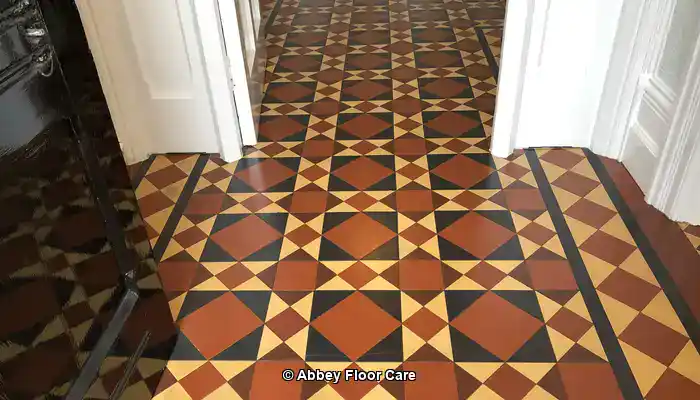
Our cleaning processes successfully eradicated years of wax and grime, followed by the application of a Lantania Avo colour-enhancing impregnating sealer, which noticeably deepened the tile colours. Finally, an acrylic topical sealer was applied for surface protection on floors installed over a damp-proof membrane, ensuring lasting beauty.
A Restored Civic Mosaic Floor Case in Chesterfield

Following a thorough cleaning and the removal of old topical sealers, the floor was sealed with an LTP Colour Enhancing Impregnating sealer. The surface was then further protected with a wax, carefully applied to ensure a seamless integration of the clay tiles into the historic fabric of the building.
Preserving Heritage Through Expert Restoration Techniques and Practices
Restoring the colour and pigment of Victorian mosaic tiles involves a multifaceted approach that blends material science, craftsmanship, and a commitment to heritage values. By utilizing premium impregnating colour-enhancing sealers from industry leaders such as Dry Treat, Lantania, and Lithofin, restorers can ensure long-term breathability, protection, and vibrancy of colours. Skilled cleaning, meticulous repair, and dedicated maintenance are essential to uphold the authenticity of these historic floors, allowing future generations to appreciate their beauty and significance.
Frequently Asked Questions (FAQs) About Victorian Mosaic Tile Restoration
What exactly are Victorian mosaic tiles and their significance?
Victorian mosaic tiles are decorative tiles that gained prominence during the 19th century, known for their vibrant colours and intricate designs. These tiles were commonly employed in both public buildings and private homes, serving as an important aspect of architectural style and history.
How can I effectively restore faded Victorian mosaic tiles?
The restoration of faded Victorian mosaic tiles entails a comprehensive procedure that includes detailed cleaning, repairing damage, applying new pigments to match the original colours, and subsequently sealing the tiles to protect them from future wear and staining.
What materials are critical for successful tile restoration?
Essential materials for tile restoration encompass specialized cleaning solutions, quality pigments, adhesives, grout, and protective sealants, all selected for their compatibility with the original tiles to ensure a seamless restoration.
How long does the tile restoration process typically take?
The duration required for tile restoration varies based on the size and condition of the area being restored, generally ranging from a few days for smaller projects to several weeks for more extensive restorations that require meticulous attention to detail.
Can I perform the restoration myself, or should I hire a professional?
Yes, smaller restoration tasks can be undertaken as DIY if you possess the required skills and tools. However, more complex repairs necessitate the expertise of professionals to ensure quality outcomes and preserve the integrity of the tiles.
What is the typical cost involved in restoring Victorian mosaic tiles?
Costs can vary widely based on project size and condition, typically ranging from a few hundred to several thousand pounds for comprehensive restorations, depending on the extent of the work required.
How do I choose the right restoration expert for my project?
Look for restoration professionals with a solid background in historical projects, favorable reviews, and a commitment to using authentic materials and techniques for optimal results that honor the tiles' heritage.
What challenges do restorers typically face during the restoration process?
Restorers often encounter challenges such as matching original colours, repairing damaged tiles, and ensuring the long-term durability and authenticity of their restoration work, all while respecting the historical significance of the tiles.
How can I effectively maintain my restored tiles to keep them looking their best?
Ongoing maintenance involves regular cleaning with pH-neutral products, avoiding harsh chemicals, periodic resealing, and promptly addressing any damage to preserve the tiles' restored condition and appearance.
What recent innovations are emerging in tile restoration techniques?
Recent advancements in the field include superior cleaning solutions, innovative types of sealants, and the incorporation of digital technology for accurate colour matching and pattern replication in restoration projects, enhancing the overall quality of restorations.
The Article Restoring Colour and Pigment to Faded Victorian Mosaic Tiles was first found on https://www.abbeyfloorcare.co.uk
The Article Restoring Colour to Faded Victorian Mosaic Tiles appeared first on https://fabritec.org
The Article Restoring Victorian Mosaic Tiles to Their Original Color Was Found On https://limitsofstrategy.com

